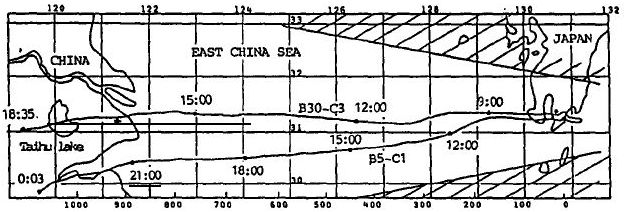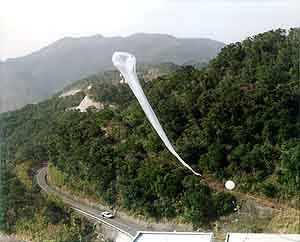
Established in February 1962, the Kagoshima Space Center (KSC) is located near the town of Uchinoura at Kyushu island at the southern tip of Japan.
It has an area (mostly undulated) of 71 hectares. Its main function is to launch medium size rockets, and for this purpose it counts with several platforms, as well as tracking and telemetry stations. Each of these posts was built after flattening the hills there and are linked by roads each other. Since its inauguration more than 300 rockets (including delivery vehicles for satellites) have been launched from there.
During a period of three years at the end of the decade of the 80's, the center became an active site for launching stratospheric balloons that made long-duration flights to the mainland of the People's Republic of China. Following is a detailed account of that effort.
Trans-Ocean flights using stratospheric balloons
The joint project called "Trans-Oceanic Flight Between Japan and China" took place between 1986 and 1988 thanks to collaboration with the Institute of Space and Aeronautical Science (ISAS - currently JAXA) by the Japanese side and the Ministry of Education, the Shanghai Astronomical Observatory and the Centre for Space Science and Technology of China Academy of Sciences, among others, by the Chinese side. The project was born during a conference held in Beijing in 1982, which evaluated the possibility of launching from the island of Kyushu stratospheric balloons that flying across the eastern China Sea would be recovered on the continent.

First, were developed models and simulations of the trajectories mainly based on existing information about the wind regime in the area for the intended months of fly when they blow from the east. This lead to conclude that during June and August flights could take place towards the coast os China with a duration between 10 and 20-hour, while in May or September could be achieved even greater lengths, but with a flight path much more unstable and erratic, which could led the balloons to divert the projected landing zone in the Shanghai area.
In 1985, another meeting -this time at the governmental level- was held in the capital of China, where the project received a strong endorsement, which allowed in 1986 to start with the flights.
The balloon launch site was installed in open field, near the facilities of the Kagoshima Space Center (KSC). For the development of transoceanic flights was necessary to have three tracking stations, one in Japanese territory and two others in China. For installation of the first, the topography of the land played a pivotal role. As the mountains surrounding the KSC extend westward of the complex, it was necessary that it be located on the east coast of Kagoshima Bay, so the site chosen was Ohnejime, located about 20 kms. west of the rocket launch base. For the Chinese side, the first of the stations was installed at the Astronomical Observatory of Shanghai. With a radius of coverage averaged about 500 kilometers for each tracking point, and being the distance between the island of Kyushu and Shanghai nearly 800 kms, the tracking of the balloons was first taken by Japan and then transferred to the Chinese side when they crossed the meridian of 124º. Additionally, the second Chinese station was located in Nanjing with the aim to further extend the range of the monitoring network.

The first test launches took place in 1986, while in the next two years, another seven flights were made, of which except two that failed due to problems with the balloon and the remote control system, all successfully reached the Asian continent. The experiments carried ranging from the X-ray astrophysics, to observation of galactic infrared sources and from studying the stratospheric levels of nitrogen to detecting high-energy electrons.
As the launch operations were conducted by the Japanese, the recovery of the payloads was in charge of their Chinese peers. They created two recovery teams which at launch time were located in areas north and south of Taihu Lake, awaiting the arrival of the balloons and their payloads. During the entire duration of the program all the missions succesfully reached this area and were promptly recovered as they fell within the territorial limits set by the atmospheric models used. The only exception occurred when one of the loads landed in an isolated mountainous terrain. However it was located thanks to the ARGOS system that the gondola was carrying and was recovered two weeks after his landing.
Despite the success collaboration, such flights were not repeated again. Part of the legacy of the program is the demonstration of the feasibility and the establishment of a safe route of flight between Japan and China, as well as the speedy recovery of the payloads. Lastly, the use of technology for shared control of long duration flights between the two countries and joint exploitation by scientists of both nations of the results were also important elements that arose from the program.
In subsequent years, the Japanese Space Agency continued to launch balloons from KSC but very sporadically and merely to perform short-duration flights.
With the creation of the current space exploration Agency (JAXA) the complex was renamed Uchinoura Space Center.
Table of balloons launched from Kagoshima Space Center, Uchinoura
| Date | Hour | Flight Duration | Experiment | Payload landing place or cause of the failure |
|---|---|---|---|---|
| 7/25/1986 | 18 h 10 m | TEST FLIGHT | East of Hangzhou, Zhejiang Province, China | |
| 7/30/1986 | 12 h 54 m | TEST FLIGHT | East lake Taihu, Zhejiang Province, China | |
| 7/29/1987 | 00:30 jst | 17 h 32 m | NITRIC OXID MEASUREMENTS | 80 Km E of Nanking, China |
| 8/3/1987 | 10 h 32 m | GALACTIC IR OBSERVATIONS | In China | |
| 8/10/1987 | 1 h 10 m | STELLAR IR OBSERVATIONS | Balloon burst | |
| 8/16/1988 | 15 h 20 m | X-RAY ASTRONOMICAL OBSERVATIONS | In Jangsu, China | |
| 8/20/1988 | 13 h 18 m | GALACTIC IR OBSERVATIONS | In China | |
| 8/23/1988 | 16 h 7 m | GALACTIC ELECTRON OBSERVATION | In China | |
| 8/25/1988 | --- | STELLAR IR OBSERVATIONS | Command Fail | |
| 9/21/1988 | 5:45 jst | --- | HIMES (Highly Maneuverable Experimental Space Vehicle) | Failure of the balloon. Aborted mission. Payload recovered 80 km E of Uchinoura, Japan |
| 2/14/1992 | --- | HIMES (Highly Maneuverable Experimental Space Vehicle) - RFT-2 | --- No Data --- | |
| 1/25/1998 | 12:03 jst | 5 h 45 m | OPTICAL OZONE SENSOR | --- No Data --- |
If you consider this website interesting or useful, you can help me to keep it up and running with a small donation to cover the operational costs. Just the equivalent of the price of a cup of coffee helps a lot.

